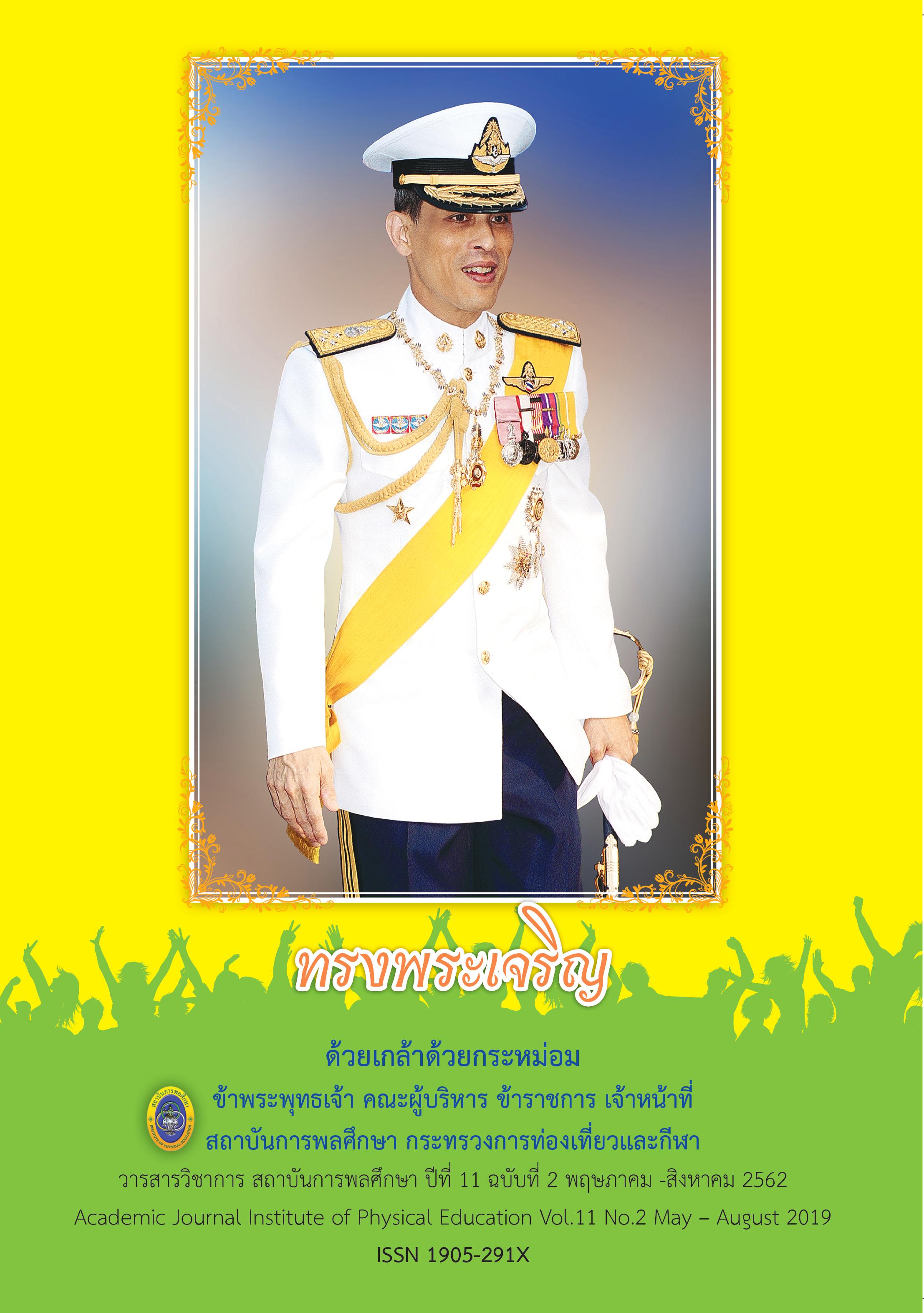THE CONSTRUCTION OF KEY PERFORMANCE INDICATORS FOR SUCCESSFUL OF BIKE FIELD FOR EXERCISE
Main Article Content
Abstract
The objectives of this research were 1) To Study the key performance indicators (KPI) for successful of bike field for Exercise in Bangkok & vicinity area. 2) To Construction of Key Performance Indicators (KPI) for Successful of Bike Field for Exercise in Bangkok & vicinity area. This research studies in quality. Research Instrument reviewed by 5 cycling experts. Use Qualitative data from in-depth interview. an tested before use and collected data by literature review and other information & in-depth interview used mix methods along with recording important information. The tape contents were analyzed with specific sampling to have feedback from 2 groups. The data were collected from 58 persons highly experienced cyclists management experts in Thailand such as 1st group: Administrators and Staff from bike field total 8 persons, 2nd group: Cyclist from governments, enterprises and private total 50 persons. Total 8 locations in the collection.
The data were analyzed by the steps of processing research that have been concluded & synchronized till classifying data groups as model and descriptive data, the conceptual research below;
Model of standard bike field from country level to international level consists of 5 dimensions determined such as; 1st dimension: concrete form of service, 2nd dimension: reliability, 3rd dimension: responsibility and 4th dimension: assurance compliance 5th dimension: empathy with the process. PDCA and System Theory.
KPI or key performance indicators finding is cyclist’s satisfaction and PDCA and System Theory quality is the distance as 1st level of safety 2nd level of with good facilities cycling lane per 1round, suitably smooth surface with cycling, happiness and variety activities in bike field 3rd level of and other services are indicators respectively. The model is a return Theory to key performance indicators for successful of Bike Field for Exercise.
Article Details
The published article is a copyright of the Academic Journal of Thailand National Sports University. The passage appeared in each article in this academic journal is a perspective of each author which is not related to the journal. Each author is required to be responsible for all components of his/her own article. If there are any mistakes, each author must be responsible for those mistakes on his/her own.
References
กระทรวงการท่องเที่ยวและกีฬา. (2559). แผนพัฒนาการกีฬาแห่งชาติ ฉบับที่ 6 พ.ศ. 2560-2564. กอง บรรณาธิการ “เส้นทางเศรษฐี. 2557.ปั่น พันล้าน จักรยานที่รัก. กรุงเทพมหานคร. สำนักพิมพ์มติชน.
คู่มือการจัดทำแผนยุทธศาสตร์ แผนพัฒนากีฬาแห่งชาติ ฉบับที่ 5 (พ.ศ.2555-2559). กรุงเทพฯ : โรงพิมพ์องค์การค้าของ สกสค.
สำนักงานสถิติแห่งชาติ. (2554). การสำรวจพฤติกรรมการเล่นกีฬาหรือออกกำลังกายของประชากร คณะคุรุศาสตร์ จุฬาลงกรณ์มหาวิทยาลัย 2552. รายงานการพัฒนาตัวบ่งชี้และเครื่องมือวัด
ตัวบ่งชี้ตามมาตรฐานการศึกษาของชาติ มาตรฐานที่ 2 แนวทางการจัดการศึกษาและมาตรฐานที่ 3 แนวการสร้างสังคมแห่งการเรียนรู้/สังคมแห่งความรู้. กรุงเทพมหานคร: สำนักงานเลขาธิการสภา การศึกษา กระทรวงศึกษาธิการ.
เอกชัย บุญยาทิษฐาน. (2553). KPI หัวใจนักบริหาร ตัวชี้วัดสมรรถนะหลัก.กรุงเทพมหานคร. บริษัท ส.เอเชียเพรส (1989) จำกัด.
อภิชัย ศรีเมือง. (2556). KPI เพื่อประเมินความสำเร็จของหัวหน้างานสำหรับผู้บริหาร. นนทบุรี. บริษัท ธิงค์ บียอนด์ บุ๊คส์ จำกัด.
Director Division of Arts & Social Sciences University of Education, LowerMall Campus Lahore.
Davis, K. and W. N. Johnใ (1989). Human Behavior at Work: Organizational Behavior. New York: McGraw-Hill Book Company.
Ernest, D. R. 1968. Management : Theory and Practice. McGraw-Hill Book Company, New York.
Griffin, R. W. (1999). Management. 6th ed. Boston Houghton Griffin.
Gulick, L. and L. Urwick (eds.). 1937. Paper on the Science of Administration.
ILLICH, I. (1974). Energy and Equity. New York: Harper & Row.
Kraiseehanat, Rattana. (1991). A Comparative Study of Self-Concept, Mental Health, and Work Satisfaction between Professional Nurse, and Technical Nurse.
Marjorie, C. H. (1986). Pattern of Aging and Social Supports in United States. New York: Fordham University.
Maslow, A. M. (1954). Motivation and Personality. New York: Harper and Row.
Mooney, J. D. and A. C. Reiley. (1931). Onward Industry! The Principles of Organization.
Nadeem, M. (2012). Participative Management Style: A Tool to Enhance Quality Education (Online). www.drmanage.com, June 19, 2017. New York: Institute of Public Administration, Columbia University.
Taylor, F. W. (2002). The Principles of Scientific Management. New York: Harper


